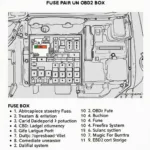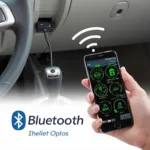Understanding e36 obd2 code reading is crucial for maintaining your BMW and diagnosing potential issues. This guide will delve into everything you need to know about reading OBD2 codes on your E36, from understanding the different types of scanners to interpreting the codes themselves.
Understanding OBD2 Codes on Your E36
OBD2, or On-Board Diagnostics II, is a standardized system that allows you to access diagnostic information about your vehicle. Your E36, depending on the year, might use OBD1 or OBD2. This information is presented in the form of codes, which can pinpoint specific problems within your car’s systems. From engine misfires to transmission issues, these codes offer valuable insights into the health of your vehicle. Knowing how to read these codes empowers you to take proactive steps in maintaining your E36.
Reading codes from your E36 requires an obd2 code readers with live time. These range from basic code readers to advanced scan tools. Choosing the right one depends on your technical expertise and the depth of information you require. Basic code readers typically display the code and a brief description, while advanced tools provide live data, allowing you to monitor sensor readings in real-time.
How to Read E36 OBD2 Codes
The process of reading OBD2 codes on an E36 is relatively straightforward. First, locate the OBD2 port, usually located under the dashboard on the driver’s side. Next, plug in your OBD2 scanner. Turn the ignition to the “on” position without starting the engine. The scanner will then communicate with your car’s computer and display any stored codes.
Interpreting the Codes
Once you have the codes, you need to understand what they mean. Each code consists of a five-digit alphanumeric sequence. The first letter indicates the system the code relates to (e.g., P for Powertrain, B for Body, C for Chassis, U for Network). The following digits provide more specific information about the issue. You can find comprehensive lists of OBD2 codes online or in repair manuals.
Common E36 OBD2 Codes and Their Meanings
Some common codes you might encounter on your E36 include P0171 (System Too Lean Bank 1) and P0300 (Random/Multiple Cylinder Misfire Detected). Understanding these codes can help you diagnose issues such as vacuum leaks, faulty oxygen sensors, or ignition problems. More information on BMW specific protocols can be found regarding obd2 communication protocol protocol bmw.
What if My E36 Has OBD1?
If your E36 is an earlier model, it might have OBD1 instead of OBD2. e36 obd1 vs obd2 header helps you understand the differences and how to read codes on an OBD1 system. The process is different, often requiring a specialized OBD1 scanner or adapter.
Tips for Effective E36 OBD2 Code Reading
- Always refer to a reliable source for code definitions.
- Clear the codes after addressing the issue to ensure the problem is resolved.
- Consider using an advanced scan tool for live data and more detailed diagnostics.
- Don’t panic if you see a code. It’s always best to consult a qualified mechanic for complex issues. Sometimes an obd2 scanner just says reading which can indicate a problem with the scanner or the connection. If you are working on an S52 engine specifically, check out our obd2 s52 article for more information.
“Accurate code reading is the first step in properly diagnosing any car issue,” says Michael Thompson, ASE Certified Master Technician. “It’s like having a conversation with your car. It tells you what’s wrong, and you just need to listen.”
“Don’t just treat the symptom, find the root cause,” adds Thompson. “OBD2 codes provide the clues you need to pinpoint the problem accurately.”
In conclusion, e36 obd2 code reading is a valuable skill for any E36 owner. By understanding how to read and interpret these codes, you can take control of your car’s maintenance and address potential issues before they become major problems.
FAQ
- What is OBD2? OBD2 is a standardized system for accessing diagnostic information from your vehicle’s computer.
- Where is the OBD2 port on an E36? It’s typically located under the dashboard on the driver’s side.
- What do the letters and numbers in an OBD2 code mean? The first letter indicates the system, and the following digits provide specific information about the issue.
- What if my E36 has OBD1? You’ll need a specialized OBD1 scanner or adapter.
- What should I do after reading a code? Consult a reliable source for the code definition and consider seeking professional help if necessary.
- How do I clear OBD2 codes? Most scanners have a function to clear codes after the issue is addressed.
- Can I read codes without a scanner? No, a scanner is required to communicate with the car’s computer.
Common Scenarios
- Check Engine Light is On: This is the most common reason to read OBD2 codes.
- Car is Running Roughly: Codes can help diagnose misfires, fuel problems, etc.
- Transmission Issues: Codes can pinpoint problems within the transmission system.
Further Reading
Check out our other articles on OBD2 for more information on specific codes and troubleshooting tips.
Need Help?
Contact us via WhatsApp: +1(641)206-8880, Email: [email protected] or visit our office at 789 Elm Street, San Francisco, CA 94102, USA. Our 24/7 customer support team is ready to assist you.

